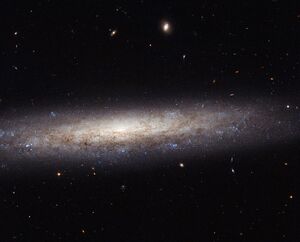Astronomy:NGC 4206
From HandWiki
Short description: Spiral galaxy in the constellation Virgo
Coordinates: ![]() 12h 15m 16.875s, +13° 01′ 25.82″
12h 15m 16.875s, +13° 01′ 25.82″
| NGC 4206 | |
|---|---|
 NGC 4206 image taken with the NASA/ESA Hubble Space Telescope | |
| Observation data (J2000 epoch) | |
| Constellation | Virgo[1] |
| Right ascension | 12h 15m 16.8s[2] |
| Declination | 13° 01′ 26.4″[2] |
| Redshift | 0.00236[2] |
| Helio radial velocity | 707 km/s[2] |
| Galactocentric velocity | 643 ± 3 km/s[3] |
| Distance | 67 Mly (20.4 Mpc)[2] |
| Group or cluster | Virgo Cluster[4][5] |
| Apparent magnitude (V) | 12.15[2] |
| Apparent magnitude (B) | 12.82[2] |
| Characteristics | |
| Type | SA(s)bc?[3] |
| Size | ~98,000 ly (30.1 kpc) (estimated)[3] |
| Apparent size (V) | 5.18 x 0.77[3] |
| Other designations | |
| IRAS 12127+1318, PGC 39183,2MASX J12151687+1301258, MCG+02-31-066, HIPASS J1215+13, IC 3064, UGC 7260[2] | |
NGC 4206 is a spiral galaxy located about 70 million light-years away from Earth in the constellation of Virgo. The galaxy is visible with most moderate amateur telescopes at 13th magnitude. It was discovered by British astronomer William Herschel on 17 April 1784 and is a member of the Virgo Cluster.[5][4]
References
- ↑ "A dusty spiral in Virgo". ESA/Hubble. http://www.spacetelescope.org/images/potw1440a/.
- ↑ 2.0 2.1 2.2 2.3 2.4 2.5 2.6 2.7 "NGC 4206". SIMBAD. Centre de données astronomiques de Strasbourg. http://simbad.u-strasbg.fr/simbad/sim-basic?Ident=NGC+4206.
- ↑ 3.0 3.1 3.2 3.3 "NASA/IPAC Extragalactic Database". Results for NGC 4206. http://nedwww.ipac.caltech.edu/.
- ↑ 4.0 4.1 R. B. Tully (1988). Nearby Galaxies Catalog. Cambridge: Cambridge University Press. ISBN 978-0-521-35299-4.
- ↑ 5.0 5.1 Binggeli, B.; Sandage, A.; Tammann, G. A. (September 1985). "Studies of the Virgo Cluster. II - A catalog of 2096 galaxies in the Virgo Cluster area. V - Luminosity functions of Virgo Cluster galaxies" (in en). The Astronomical Journal 90: 1681. doi:10.1086/113874. ISSN 0004-6256. Bibcode: 1985AJ.....90.1681B.
External links
 |

